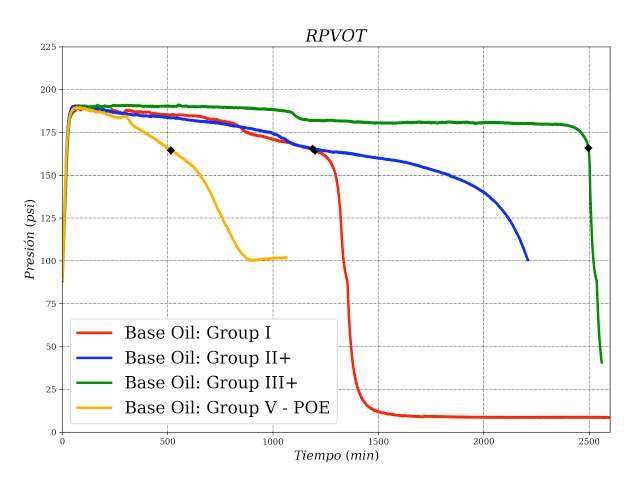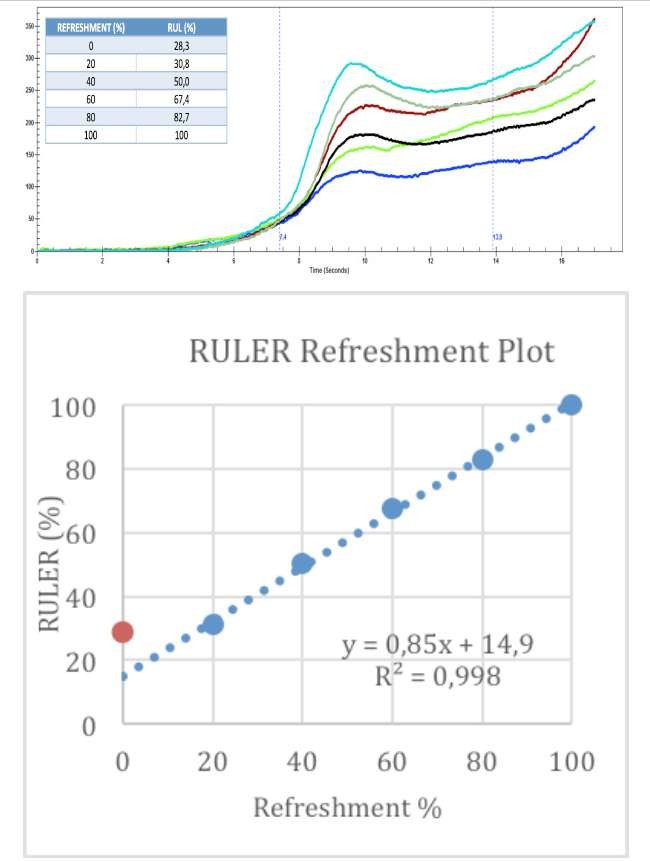TURBINE OIL
Assessing Oxidation Condition and Lubricant Refreshment in Turbine Oils
By Andres B. Lantos, WearCheck Argentina*
CONDITION MONITORING
* Dave Wooton
2
, Sebastián Lauría
1
, Andrés Bodner
1
, Gabriel Lucchiari
1
, Esteban Lantos
1
1 Laboratorio Dr. Lantos – WearCheck Argentina. Buenos Aires, Argentina. 2 Wooton Consulting. Beaverdam, VA 23015 USA
Abstract Turbines are critical pieces of equipment for power plants and related industries. Varnish formation is the first root cause for downtime and loss of reliability in turbines. The lubricant’s oxidation condition can be effectively monitored through RULER (Remaining Useful Life Evaluation Routine), MPC (Membrane Patch Colorimetry) and RPVOT (Rotating Pressure Vessel Oxidation Test) tests. Besides the nominal ASTM (American Society for Testing and Materials) value for these tests, significant information can be gathered from digging into these tests and integrating their outcomes. One major application for this integration is the estimation of the lubricant refreshment for lean operation. Through lab tests, this can be accurately estimated, by planning ahead of the upcoming maintenance intervention. This method will be shown, together with case studies.
Introduction Turbines are essential components for power generation and heavy industries, where downtime and failures can result in production loss, penalties, and operational disruption. While wear in turbines occurs primarily due to poor lubricant
To prevent oxidation, turbine lubricants contain around 1% antioxidants, which protect the base oil from thermal and oxidative stress.
condition, the primary cause of turbine failure is the accumulation of deposits, leading to issues like sticking valves, blockages, and inefficient heat exchange. Varnish, often linked to oxidation processes, is a common type of deposit that forms as a result of sacrificed antioxidants and oxidation byproducts. Varnish removal incurs high costs in terms of downtime and equipment replacement, making the monitoring of turbine oil oxidation condition crucial.
To prevent oxidation, turbine lubricants contain around 1% antioxidants, which protect the base oil from thermal and oxidative stress. While the generally accepted threshold for using turbine oils is when the remaining active antioxidants are at 25% of the original formulation, varnish issues can emerge even when remaining antioxidants are as high as 60%. Maintaining a high dose of antioxidants and low varnish potential is essential to ensure reliable operation, and lubricant refreshment can play a pivotal role in achieving this goal.
Analytical Techniques for Lubricant Evaluation Three key tests are used to evaluate the oxidation condition of turbine lubricants: RULER (Remaining Useful Life Evaluation Routine), MPC (Membrane Patch Colorimetry), and RPVOT (Rotating Pressure Vessel Oxidation Test). These tests provide valuable insights into the oxidation condition and the remaining antioxidant levels.
Membrane Patch Colorimetry (MPC) (ASTM D7843) is a method for determining varnish formation in mineral turbine oils. In analytical chemistry, procedures can be classified as either end point or standardised. Typical end-point procedures are titrations such as Acid Number (ASTM D974) or Karl Fischer (ASTM D6304). MPC involves heating the lubri-cant at turbine operating temperature for 24 hours to redissolve varnish, followed by 72 hours of standing for varnish re-precipitation. The colour intensity of the patch formed on a membrane filter is measured, and a higher MPC value indicates higher varnish retention. MPC values above 30 are concerning, above 20 are alarming, and below 15 are considered safe.

Figure 1. MPC is a standardised method in which precipitation time is critical (part I).
RPVOT (Rotating Pressure Vessel Oxidation Test) (ASTM D2272) is an oxidation simulator. This test simulates oxidation by pressurising lubricant samples in the presence of oxygen and a catalyst. The induction period, the time until the pressure drops by 25.4 psi, indicates antioxidant depletion. Different base oils and antioxidant formulations yield distinct RPVOT curves, offering valuable insights into the oxidation behaviour.
RULER (Remaining Useful Life Evaluation Routine) (ASTM D6971) is a voltammetric method for quantifying antioxidants. By analysing the oxidised products of antioxidants, this test provides an accurate assessment of remaining active antioxidants. For highly degraded samples, extrapolation is necessary to obtain reliable results.
RULER is an excellent methodology for monitoring the remaining active antioxidants. Given that the method oxidises the antioxidant, the result is dependable of the real remaining antioxidant potential. However, when the remaining antioxidants are very low and the peaks are very shallow it is possible to make errors in the antioxidant quantification, typically in excess.
Excess quantification in degraded samples is dangerous, because should antioxidants completely deplete, the lubricant will fall into massive oxidation in a very short period, causing huge damage. To avoid falling into this analytical pit, it is possible to better estimate the remaining antioxidant % by extrapolation.
When preparing mixtures of new and used oil, we can define the Refreshment % such that Refreshment = 0% implies used oil; and Refreshment = 100% implies full lubricant replacement.
Consider the following case study of a Gas Turbine with a mineral ISO VG 32 lubricant supplemented with an R&O package and 43,000 operation hours. The RULER for this sample resulted in 28,3% remaining antioxidant, very close to the condemning limit.

Figure 2: RPVOT curves for different base oil formulations. Figure 3. RULER can be quantified by extrapolation in degraded samples.
This article has been summarised. To read the full article, please follow this link: https://www.wearcheck.co.za/shared/TB81.pdf

Figure 3. RULER can be quantified by extrapolation in degraded samples.
To assess the RULER value better, we proceeded to perform the extrapolation method. For this, the complementary mixtures of new and used oil to cover 0% to 100% refreshments were prepared. After thorough homogenisation, RULER was tested for all samples. Figure 3 shows the RULER outcome.
Consider a gas turbine lubricated with a Group I oil supplemented with a mixed antioxidant package. This system has run for 55,000 operating hours with a 10% refreshment after 44,000 operating hours.
Refreshment plots were performed for this lubricant.
Building an Oxidation Condition Model for Lubricant Refreshment Creating a refreshment model involves analysing the turbine’s oxidation condition and proposing a lubricant refreshment strategy. By assessing the relationship between the actual condition of the lubricant and a hypothetical scenario with a full lubricant change, a comprehensive model can be constructed. This model guides decisions on the required refreshment percentage to achieve optimal oxidation condition for reliable turbine operation.
Refreshment Strategies Two main strategies for maintaining high antioxidant levels are “bleed and feed” and “additive replenishment.”
• Bleed and Feed: This conservative approach involves bleeding a portion of the in-service oil and replenishing it with fresh lubricant. While effective, this method can be costly and wasteful as the bled base oil is usual-ly not oxidized.
• Additive Replenishment: This strategy involves slowly adding antioxidant concentrates to the in-service oil to maintain desired antioxidant levels. It offers economical advantages by conserving base oil, but it requires careful formulation and compatibility testing to prevent undesired reactions and deposit formation.
Conclusion Monitoring lubricant oxidation is crucial for ensuring reliable turbine operation and preventing costly failures. Analytical techniques such as RULER, MPC, and RPVOT provide valuable insights into the oxidation condition and the remaining antioxidant levels. By integrating the outcomes of these tests and creating oxidation condition models, effective lubricant refreshment strategies can be devised. These strategies, whether through bleed and feed or additive replenishment, contribute to extending the lifespan of turbine oils and enhancing overall turbine reliability. While both approaches have their merits and challenges, they collectively underline the significance of meticulous maintenance and monitoring practices in the realm of turbine operation. .
REFERENCES
1. Lubricant Deposit Characterisation. Dave
Wooton & Greg Livingstone. Oildoc 2003
2. Akihiko Yano, Shintaro Watanabe , Yasunori Miyazaki, Mitsuyoshi Tsuchiya & Yuji Yamamoto (2004) Study on Sludge Formation during the Oxidation Process of Turbine Oils, Tribology Transactions, 47:1, 111-122
3. Turbine oil bleed & feed: An expensive option. Greg Livingstone, Turbomachinery 2014
4. Bleed & Feed, TMI Staff, Turbomachinery 2014
5. Lubrication Excellence 2007 William Moehle, Vince Gatto, Dave Wooton and Greg Livingstone, “.Practical Approaches to Controlling Sludge and Varnish in Turbine Oils”.
6. Norfolk, VA Vincent J. Gatto, William E. Moehle, Tyler W. Cobb, Emily R. Schneller, “Oxidation Fundamentals and its Application to Turbine Oil Testing” - April 2006 JAI Volume 3, Issue 4JAI13498.